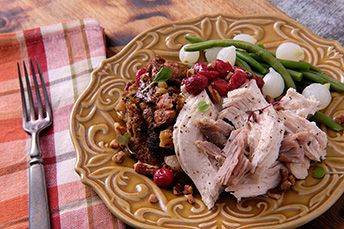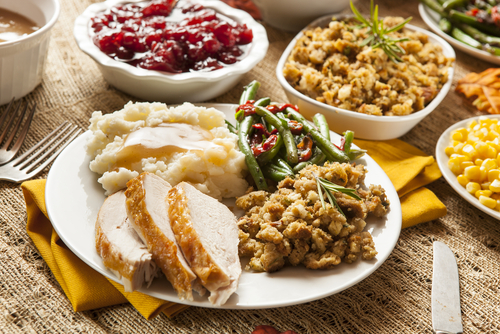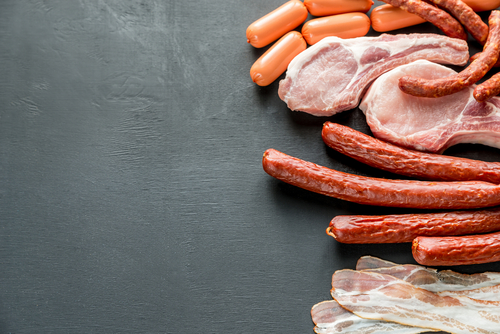Cut Your Stroke Risk This Thanksgiving
It’s almost Thanksgiving, a time when many of us aren’t thinking about our diets and exercise patterns. But according to new research from the American Heart Association, many of the items we enjoy during Thanksgiving may be increasing our risk for stroke and should be limited.
In a 27-year study of more than 117,000 health care professionals, researchers found that the type of fat eaten may be more important than the amount when it comes to cardiovascular health. Participants of the study who ate higher amounts of non-dairy animal fat had a 16% increased risk for stroke compared to those who ate the lowest amounts. They found that dairy fat was not associated with stroke risk.
Stroke is the fifth leading cause of death in the US, and this information on how diet plays a role will help many people by making small modifications to their diet to lessen the burden of strokes. A stroke occurs when blood flow is cut off to a part of the brain. This can be caused by a blood clot, called an ischemic stroke, or by the rupturing of a blood vessel, called a hemorrhagic stroke.
For the traditional Thanksgiving dinner, the average American consumes around 130 grams of fat and around 50 grams of saturated fat, according to the Calorie Control Council. From the cheeseball and crackers for an appetizer to the stuffing, gravy, and green bean casserole at the main meal and the pecan pie for dessert, all of these fat grams add up. Most of these fat grams may come from saturated fats rather than the unsaturated fats that increases our risk of stroke.
Traditional Thanksgiving Dinner
| Food Item | Serving Size | Calories | Fat Grams |
| Cheeseball (w/nuts) | 2 Tbsp. | 246 | 20 |
| Crackers | 10 | 177 | 7 |
| Potato Chips | 1 oz. (10 chips) | 150 | 10 |
| Onion Dip | 2 Tbsp. | 60 | 5 |
| Roasted Turkey (meat & skin) | 4 slices (4 oz.) | 214 | 8.5 |
| Cornbread | 1 square | 152 | 5 |
| Bread Stuffing | 1 cup | 355 | 17 |
| Giblet Gravy (w/milk & flour) | ½ cup | 179 | 13 |
| Sweet Potato Casserole | 1 cup | 276 | 6 |
| Green Bean Casserole | 1 cup | 143 | 8 |
| Cranberry Sauce | ½ cup | 209 | 0 |
| Pecan Pie | 1/8 of 9” Pie | 456 | 21 |
| Butter (for bread) | 1 Tbsp. | 102 | 11 |
| TOTAL | 2719 | 132 |
Fat is a needed nutrient in our diet. Dietary fat is essential for energy and proper cell functions. They help protect our organs and keep us warm. Fat also helps us absorb important nutrients and produce hormones.
Too much fat can add extra calories to the diet and, depending on the type, may increase your risk for stroke. Fats that are solid at room temperature tend to be saturated fats and trans fats and are referred to as “bad fat.” These types of fat are known to raise the LDL (“bad”) cholesterol levels in your blood. For example, this study found that eating higher total amounts of red meat, processed red meat, and non-dairy animal fat increased the risk of stroke. However, consuming more vegetable oil or polyunsaturated fat lowered the risk.
During this study, investigators analyzed 27 years of follow-up from 117,136 participants enrolled in the Nurses’ Health Study and the Health Professionals Follow-Up Study. They were 50-years old on average, 63% were women, and 97% were white, and all participants were free of heart disease and cancer at sign up. When starting the study and every four years throughout the study, participants completed food frequency questionnaires that averaged the amount and source of fats over the past year.
Researchers calculated the cumulative average and divided the participants into five groups depending on their dietary choices. They calculated total red meat by including all beef, pork, or lamb and processed red meat including bacon, sausage, hot dogs, salami, and other processed meats.
They found that participants in the highest group of non-dairy animal fat were 16% more likely to experience a stroke. Those who ate the most vegetable fat and the most polyunsaturated fats were 12% less likely to experience a stroke. Every serving of red meat daily led to an 8% higher risk for stroke. Those consuming one or more servings of processed red meat had a 12% higher risk for stroke.
So, what do these results mean for our Thanksgiving dinner?
- The researchers recommended everyone reduce their consumption of red meat and processed meat, so stay away from the cheeseball with bacon bits covering the outside and, if there is an option, stick to white meat turkey without the skin.
- Replace animal fat in recipes and replace them with non-tropical vegetable oils such as olive oil, avocado oil, or soybean oil to lower your stroke risk.
- Replace processed meats with other protein sources, in particular, replace high-fat animal protein with plant sources such as beans, legumes, nuts, and seeds. According to the AHA, “Many processed meats are high in salt and saturated fat, and low in vegetable fat. Research shows that replacing processed meat with other protein sources is associated with lower death rates.”
- Have more plant-based meals. You do not have to become vegan, but reducing the amount of animal fats you consume overall will benefit your cardiovascular health.
The lead author, Alice H. Lichtenstein, D. Sc., FAHA, of the American Heart Association’s 2021 scientific statement, Dietary Guidance to Improve Cardiovascular Health, suggests the following advice. “Key features of a heart-healthy diet pattern are to balance calorie intake with calorie needs to achieve and maintain a healthy weight, choose whole grains, lean and plant-based protein and a variety of fruits and vegetables; limit salt, sugar, animal fat, processed foods, and alcohol.”
At Seattle Sutton’s Healthy Eating, we already offer meals with limited amounts of animal fats and focus on more plant-based and dairy-based fats. We make all of our salad dressing with plant-based oils from scratch. We include a variety of beans, legumes, nuts, and seeds and even make our own nut butters to control the sodium, added sugars, and types of fat present in these items. Our menus do not include no red meat or pork. And we follow the American Heart Association and American Diabetes Association guidelines for the amount of fat and saturated fats in our meals.

Every year, we offer our customers a Thanksgiving Dinner as part of their regular orders so they can celebrate the holidays with traditional food made healthier by using better-for-you ingredients and by focusing on portion control. The American Heart Association would be proud of the Seattle Sutton’s Healthy Eating Thanksgiving Dinner and how it cuts back on saturated and trans fats and focuses on healthier plant-based fats. It features oven-roasted, no salt added turkey breast without the skin; apple rosemary stuffing with no processed meats and whole grains; turkey gravy made with canola oil; roasted green beans with fresh green beans, shitake mushroom, and olive oil; orange-cranberry sauce with oranges and whole cranberries; and a petite pumpkin cheesecake for dessert. Just because you are on a Medically Tailored Diet doesn’t mean you should miss out on the holidays!
Seattle Sutton’s Healthy Eating Thanksgiving Dinner- 1200 Calorie Plan
| Food Item | Serving Size | Calories | Fat Grams |
| Oven Roasted Turkey | 3 oz. | 89 calories | 0 g |
| Apple Rosemary Stuffing | 2.5 oz. | 179 calories | 4 g |
| Turkey Gravy | 2 oz. | 12 calories | 0 g |
| Roasted Green Beans | 3 oz. | 51 calories | 1 g |
| Orange Cranberry Sauce | 2 oz. | 45 calories | 0 g |
| Pumpkin Cheesecake | 1 each | 130 calories | 7 g |
| TOTAL | 500 | 12 g |
By choosing Seattle Sutton’s Healthy Eating Thanksgiving Dinner over the traditional Thanksgiving Dinner, you save 2,219 calories and 120 grams of fat!!!! Our meal only contains 5 grams of saturated fat, 26% of the daily value, while the traditional meal is likely over 100% of the daily value. And our meals are 33% of your daily value of sodium, much lower than the traditional dinner, as well.
By focusing on decreasing the fat by using leaner proteins, plant-based oils, leaving off processed meats, and focusing on portion control, we can cut calories, fat, and saturated fats. The above Traditional Thanksgiving dinner has an average of 50 grams of “bad,” saturated fats, while our dinner has 5 grams. By making simple recipe swaps and practicing portion control, you have immense power in controlling your risk for stroke.
Want to try Seattle Sutton’s Healthy Eating? Learn more on our website. You’ll be thankful that you did!



